Case #1 Treatment of an injured elephant: Date: 8th July 2014 Species: Elephant Sex: Male Age: 35 years old Location: Oldonyoiro GPS Location: 37° N0280523 0092906 History: This elephant was first reported to have shown leg carrying lameness affecting the right hind limb in Mpus Kutuk conservancy on 8th July 2014
Case #1 Treatment of an injured elephant:
Date: 8th July 2014
Species: Elephant
Sex: Male
Age: 35 years old
Location: Oldonyoiro
GPS Location: 37° N0280523 0092906
History:
This elephant was first reported to have shown leg carrying lameness affecting the right hind limb in Mpus Kutuk conservancy on 8th July 2014. It was spotted by Samburu Trust scouts in Tale area and reported through a KWS patrol base in Oldonyoiro. The elephant was immobilized for examination and treatment on 13th July and later reviewed on 17th July in Meibae conservancy after it crossed the Ewaso river.
Procedure and findings:
Darting was conducted from a helicopter using Etorphine Hcl 18mg in a single 1.5cc DanInject dart with a 2.2 × 60mm needle. The dart was placed into the dorsal muscles at the left rump. Induction time was 5 minutes. Examination showed swollen thigh muscles of the right hind limbs. We attempted manipulation and palpation of the limb to identify and localize the injury. Instability of the stifle joint was noted, no other findings were recorded.
Diagnosis and treatment:
Stifle joint luxation was suspected 5% Flunixin Meglumine 100ml deep intramuscular Betamox trihydrate to cover for secondary bacterial infection After treatment procedure, the animal was revived from anesthesia using Diprenophine Hcl 54mg injected through superficial ear veins.
Prognosis and recommendation:
Joint luxation in elephants has a poor prognosis for recovery mainly due to an inability to reduce and stabilize the joint impeded by the massive weight of these animals. A review of this case on 17th July showed no significant improvement though the animal could hobble around. In the 5 days post treatment it had moved approximately 8 Km crossing the Ewaso nyiro river into the Meibae conservancy and was reported to be moving towards an area called Seiya lugga. It was still in fair body condition but going forward its inability to access nutritious browse and water will negatively affect the health of this animal.

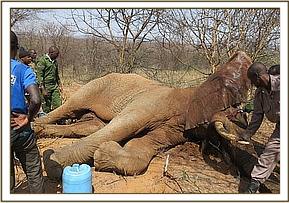
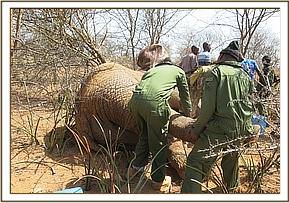

Case #2 Treatment of an injured elephant:
Date: 11th July 2014
Species: Elephant
Sex: Male
Location: Rojowero River
History:
A male adult elephant was reported wounded by tour guides from Elsas Kopje during a routine game drive along the Rojowero river on 11th July 2014. It was in a herd of approximately 60 elephants and was discharging pus on its flank. The Meru veterinary unit quickly responded while the guides and visitors monitored the herd from a safe distance.
Procedure and findings:
After a quick observation the elephant was darted from a vehicle following standard immobilization procedure. Etorphine hydrochloride 16mg was used in a 1.5 cc DanInject dart. Following darting the elephant remained calm and fell onto left lateral recumbency after seven minutes. Examination revealed a deep dorso-ventral suppurative stab wound into the right flank muscles caused by a sharp object. The wound was more than 6 inches deep on probing with a forceps and discharged pus. The elephant was also in poor body condition as a result of septicemia.
Treatment:
-The wound was scrubbed with plenty of water , debrided using dilute hydrogen peroxide and lavaged with povidone iodine -Topical antimicrobial spray Oxytetracycline was applied -Long acting Betamox trihydrate 30 grams injected intramuscularly -Multivitamin injection 200 milliliter IM -This animal is expected to make a complete recovery in the coming days.


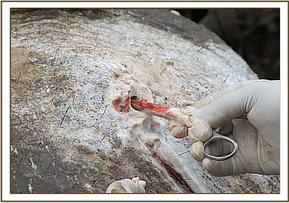
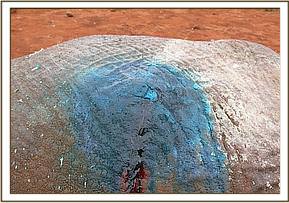

Case #3 Chronic wasting disease in elephant in Meibae conservancy:
Date: 17th July 2014
Species: Elephant
Sex: Male
Age: Adult
Location: Meibae Conservancy
History:
On 17th July 2014 a twelve year old male elephant in Meibae conservancy was reported to have shown severe emaciation with little movement for the previous three weeks.
Immobilisation:
Scouts from the conservancy monitored its movement daily; therefore the animal was easily located for treatment on a lugga along the banks of Ewaso nyiro river. For immobilization, Etorphine hydrochloride 6mg was administered using a DanInject darting system into the gluteal muscles. Darting was done on foot.
Examination:
On examination no physical injury was found and the emaciation was attributed to an internal disease condition. Long acting Betamox 15000mg and Multivitamin injection 100ml was administered intramuscularly. Diprenophine hydrochloride was given intravenously to revive this animal from anesthesia.
Prognosis:
For recovery is guarded due to the chronic course of this case.
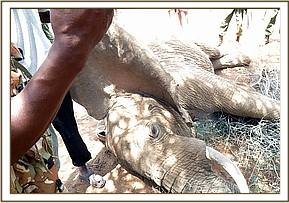
Case #4 Snare removal in an Elephant in Lewa Wildlife Conservancy:
Date: 22nd July 2014
Species: Elephant
Sex: Male
Age: Adult
Location: Lewa Conservancy
History:
A five year old male elephant was reported to be showing lameness and dragging a wire snare on its right hind limb by a research team on patrol in Lewa wildlife conservancy who monitored its movement. This animal was immobilized on 22nd July 2014 for removal of the snare.
Procedure:
The injured elephant which was in a herd of twelve elephants was easily identified in an open grassland area which is ideal for darting. For immobilization we darted the animal from a vehicle using Etorphine Hcl 2mg in a 1.5cc DanInject dart into the gluteal muscles. After five minutes he fell onto lateral recumbency and we quickly drove the herd away despite strong resistance by its mother who came to its rescue. On contact with the recumbent elephant its trunk was stretched to ensure open airway and its ear pinna was flipped to cover the eye to prevent visual stimulation and minimize stress.
Examination Results:
Examination showed a plain wire snare around the right mid tibia which though tight had not cut through the skin. To remove the snare we cut using a wire cutter. Diprenophine hydrochloride 6mg was injected intravenously into the superficial ear vein to revive the elephant from anesthesia. He was soon reunited with its mother.
Prognosis for recovery:
Although the snare around the leg was tight this young elephant was spotted before any injury occurred, therefore, we expect that this animal will live a healthy life.
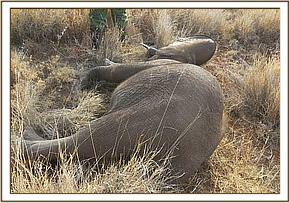
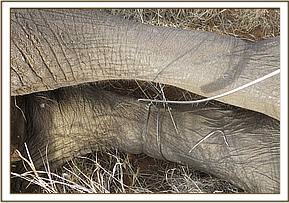
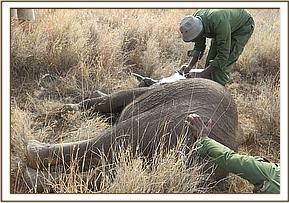

Case #5 Injured in a black rhino:
Date: 23rd July 2014
Species: Black Rhino
Sex: Male
Age: Adult
Location: Solio Ranch
GPS Coordinates: 37 M 026 9240
UTM 9975186
History:
Leg carrying lameness affecting the left hind limb for the past 24 hours with little movement and was unable to feed.
Procedure:
This animal was immobilized for clinical evaluation on 23rd July 2014 in Solio ranch. Darting was done on foot using a combination of Etorphine hydrochloride 4mg with Xylazine hydrochloride 60mg in a 1.5 cc dart and a 2.2 × 60 mm needle delivered in a DanInject darting system into the gluteal muscles. Induction time was 12 minutes after which the animal fell on sternal recumbency. He was rolled onto right lateral recumbency for examination.
Findings:
-Hyperflexion and instability of the left hock joint -Rupture of the joint capsule and tears on the skin around the joint -Tears on the rectum, perineum and the prepuce with a deep wound 5cm in diameter into the mid perineum -Lacerations on the skin at the flank
Diagnosis:
Traumatic disarticulation of the left metatarso – phalangeal joint
Management:
-Euthanasia by gunshot -Both its rear and front horns were excised and taken for custody at the Aberdares national park
Discussion:
Findings on this animal are consistent with injuries sustained in a fight. Mature male black rhinos are highly territorial and will aggressively defend their territories. Joint disarticulation particularly in black rhinos has a poor prognosis for recovery mainly due to an inability to reduce and stabilize the joint impeded by their massive weight. Injuries in this case were considered severe and not amenable to treatment. Euthanasia was considered in view of its welfare, viability of treatment and health prospects for this animal.

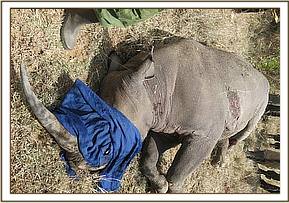
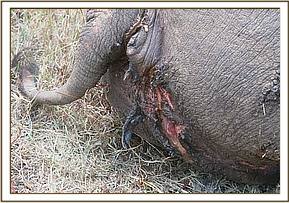


Case #6 Detusking to mitigate human elephant conflict in Meru national park:
History:
For ten years prior to May 2014, farming community living along the western boundary of Meru national park reported zero incidences of human elephant conflict (HEC). This has been attributed to an effective seventeen kilometer 16 strand electric fence which was constructed by KWS in 2004 to insulate the park and protect crops and livestock. However, in June 2014 ten incidences of crop raids by elephants were recorded in Kindani and Kianda locations on the western part of the park. An analysis of the incidences showed that all raids occurred at night when elephants tactfully break the electric fence to access the farms and later retreated to the park before dawn. A response team headed by the community warden identified five bull elephants responsible for damage to fences. Four out of five problem bulls had previously been fitted with GSM/GPS collars in Laikipia and had a history of fence breaking. They were translocated to Meru national park one year earlier to mitigate HEC in Laikipia. In July 2014, the Kenya Wildlife Service management approved detusking of four problem elephants to prevent further damage to crops, loss of community livelihood and to reduce threat to human lives. Procedure Problem elephants were monitored for one month in June 2014. Damage to fences and crops caused by elephants were reported to a patrol team who identified and photographed these individuals. An aircraft also assisted in monitoring movements of candidate elephants during routine park patrol.
Date: Capture and detusking of elephants was done on 10th July 2014
Species: Elephant
Location: Meru National Park
Procedure:
Elephants were darted from a helicopter using Etorphine hydrochloride 18mg in a 1.5cc dart delivered using a DanInject darting system. Induction time averaged 13 minutes. The animals were positioned on lateral recumbency during the tusk trimming. The full length of the tusk was measured from its tip to the point of skin contact and two thirds of the tusk was cut off using a power saw. A third of the tusk was left to ensure that the central nerve was not exposed. Petroleum jelly was applied to the cut surfaces of the tusks to prevent cracking and chipping. Subsequently, the animals were revived with Diprenorphine hydrochloride 54mg administered intravenously through the ear vein.
Discussion:
Three male elephants were successfully immobilized and tusks trimmed. A fourth elephant fell into the river during the immobilization procedure and had to be revived urgently. No incidences of HEC have been reported in three weeks monitoring post detusking. In conclusion, elephant detusking was effective in reducing HEC incidences but may have a negative effect on elephant behavior, access to nutritious feed and aesthetic value of detusked elephants. Long term monitoring of detusked elephants is recommended to study the effect of tusk trimming on elephant behaviour.
Other clinical cases attended:
A security dog in Meru national park suffered a laceration on its claw. The wound was cleaned and dressed with topical antimicrobial spray.

